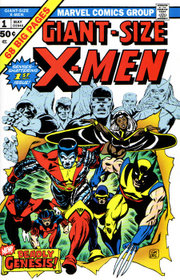The X-Men franchise, with its original stories of youthful alienation in which teens literally are the freaks they often figuratively feel like, has grown to become one of the most popular comic books, producing dozens of spin-off series over the years and turning some of its writers and artists into industry stars.
Since the early 1990s, the X-Men have been adapted into many other media, most notably as two animated television series (X-Men and X-Men: Evolution) and two hit movies from 20th Century Fox (X-Men and X2, sometimes erroneously called X2: X-Men United, a marketing phrase not on the film itself). A third X-Men movie, directed by Brett Ratner, is scheduled for release in May of 2006.
The X-Men are mutants, who in the Marvel universe are humans who, through a sudden leap in evolution, are born with latent superhuman abilities, which generally manifest themselves at puberty. Ordinary humans, homo sapiens, often hate mutants, here termed homo superior because of prejudice and the fear that mutants will replace them. It must be noted, however, that not all of humanity fears and hates mutantkind. This fact is worsened by a number of mutants, and most notably the team's archnemeses Magneto and Apocalypse, who use their powers to try to disrupt and dominate human society. The X-Men were gathered by the benevolent Professor Charles Xavier, a.k.a. Professor X, a wealthy mutant who founded an academy to train young mutants to protect themselves and the world from Magneto and other threats.
The X-Men franchise contains a richly diverse cast that is perhaps comics' most multicultural. During the 1970s, the roster was changed to further reflect this multiculturalism, adding characters from Germany, Ireland, Russia, Africa, and Japan. This multicultural theme has persisted over the years, with more and more characters of different ethnicities and cultural backgrounds constantly being added to the mythos.
The team's name is derived from the fact that mutants are "extra"-powered due to their "x-factor gene", and was coined by Professor X. Co-creator Lee recalled in his book Son of Origins of Marvel Comics and elsewhere that he devised the series title after Marvel publisher Martin Goodman turned down the initial name, "The Mutants."
History Of X-Men
Beginning
The X-Men were founded by the paraplegic telepath Professor Charles Xavier, a.k.a. Professor X. Xavier gathered the X-Men under the cover of Professor Xavier's School for Gifted Youngsters at a large country estate at 1407 Graymalkin Lane in Salem Center, a city in Westchester County, New York. The original X-Men consisted of five teenagers still learning to control their powers, namely Cyclops (Scott Summers), Marvel Girl (Jean Grey), Angel (Warren Worthington), Beast (Hank McCoy) and Iceman (Bobby Drake). Early X-Men issues also introduced the team's archnemesis, Magneto and his Brotherhood of Evil Mutants, featuring Quicksilver, Scarlet Witch, Mastermind, and the Toad.
In 1969, writer Roy Thomas and artist Neal Adams rejuvenated the franchise and introduced two new characters, Havok (Alex Summers) and Polaris (Lorna Dane). However, these early X-Men issues failed to attract sales, and Marvel stopped producing new stories with issue #66. After a hiatus, the series continued with reprint of earlier material in issue #67-93.
1970s
In Giant-Size X-Men #1 (1975), writer Len Wein and artist Dave Cockrum introduced a new team that would appear in new issues of The X-Men, beginning with issue #94. Rather than teenagers, this group consisted of adults who hailed from a variety of nations and cultures. The "all-new, all-different X-Men" were led by Cyclops from the original team, and consisted of the newly created Thunderbird (John Proudstar), Colossus (Piotr Rasputin), Nightcrawler (Kurt Wagner), Storm (Ororo Munroe), and the preexisting Sunfire (Shiro Yashida) and Banshee (Sean Cassidy), and most notably, the previously introduced Wolverine (Logan), who would become the breakout character.
The revived series was illustrated by Cockrum and later John Byrne, and written by Chris Claremont, who would become the series' longest-standing contributor. The run met great critical acclaim and produced the "Dark Phoenix Saga" and "Days of Future Past", arguably two of the greatest story arcs in Marvel Comics, as well as X-Men: God Loves, Man Kills, the base of the 2003 movie X2. New characters and teams that were introduced included Kitty Pryde, the Morlocks, the White Queen of the Hellfire Club, Rogue, Rachel Summers and Dazzler (Alison Blaire), amongst others.
1980s
In the 1980s, the growing popularity of Uncanny X-Men and the rise of comic book specialty stores lead to the introduction of several spin-off series nicknamed "X-Books", most notably The New Mutants, X-Factor, Excalibur and others. This plethora of X-Men-related titles led to the rise of crossovers (sometimes called "X-Overs"), storylines which would overlap into several X-Books, sometimes for months at a time and usually once per year, including the Mutant Massacre, the Fall of the Mutants, and Inferno.
Notable additions to the X-Men have been Longshot, Jubilee (Jubilation Lee), Gambit (Remy LeBeau), Bishop, White Queen (Emma Frost), and Psylocke (Betsy Braddock). A controversial move was to have Professor X relocate to space in 1986 to be with his beloved Lilandra, queen of the Shi'ar empire, making Magneto the head of the X-Men. This period also included the arrival of the mysterious Madelyne Pryor and the return of Jean Grey.
1990s
In 1991, Marvel revised the entire lineup of X-books, creating X-Force, led by the mysterious warhawk Cable, written by Rob Liefeld and Fabian Nicieza, and launched a second X-Men series, simply called X-Men (the original series of this title having been already renamed to Uncanny X-Men), written by Claremont and illustrated by Jim Lee.
Read more at Wikipedia.org




